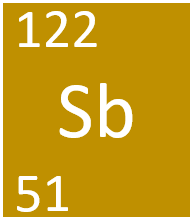Difference between revisions of "Antimony"
| Line 4: | Line 4: | ||
==Key Stage 3== | ==Key Stage 3== | ||
===Meaning=== | ===Meaning=== | ||
| − | [[File: | + | [[File:AntimonySymbol1.png|right|300px|thumb|The [[Chemical Symbol|chemical symbol]] for [[Antimony]].]] |
[[Antimony]] is a [[Group 5]] [[metalloid]] [[element]], on the [[Periodic Table]], with an [[Atomic Number|atomic number]] of 51. | [[Antimony]] is a [[Group 5]] [[metalloid]] [[element]], on the [[Periodic Table]], with an [[Atomic Number|atomic number]] of 51. | ||
Revision as of 21:28, 2 April 2019
Contents
Key Stage 2
Meaning
Key Stage 3
Meaning
Antimony is a Group 5 metalloid element, on the Periodic Table, with an atomic number of 51.
About Antimony
- Antimony has the chemical symbol Sb.
Atomic Structure
- Antimony as 51 protons and 71 neutrons in its nucleus giving it an Atomic Number of 51 and an atomic mass of 122.
- Antimony is in Period 5 of the Periodic Table because it has 5 electron shells.
Properties
- Antimony is a shiny solid at room temperature.
Key Stage 4
Meaning
Antimony is a Group 5 metalloid element, on the Periodic Table, with 51 protons in the nucleus.
About Antimony
- Antimony has the chemical symbol Sb.
Atomic Structure
- The most stable isotope of Antimony has 71 neutrons in its nucleus giving it an atomic mass of 122.
- Antimony is in Period 5 of the Periodic Table because it has 5 electron shells.
Properties
- Antimony is a metalloid element so in some conditions it is an electrical conductor.
- Antimony is a shiny solid at standard temperature and pressure and has a high melting point.
